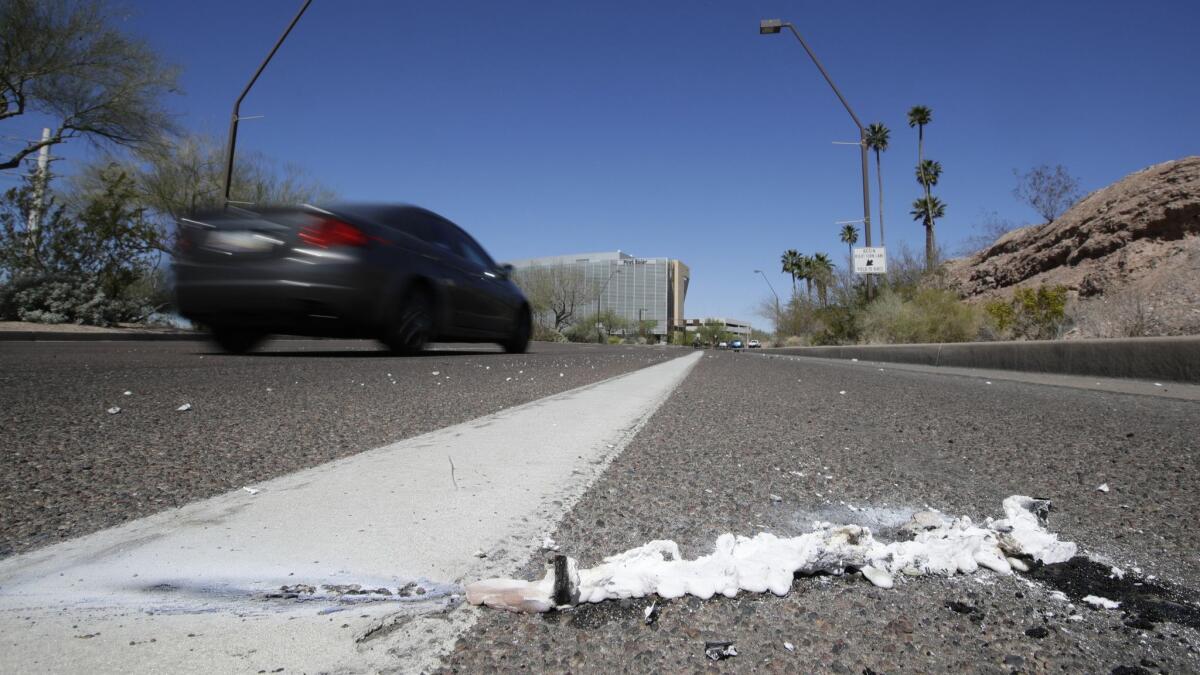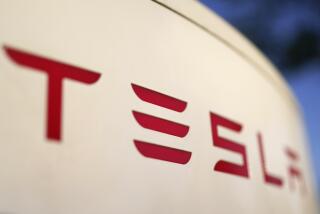Self-driving cars may ultimately be safer than human drivers. But after a pedestrian’s death, will the public buy it?

As long as robot cars roam public streets and highways, they will occasionally kill people. That’s an ugly truth that no one in the driverless vehicle industry can deny.
Will those robot cars kill people at significantly lower rates than drunk, stoned, tired or distracted human drivers do now? Automakers, technology companies, politicians and regulators are betting they will, as driverless vehicles are rolling out faster than almost anyone expected as recently as a year ago.
But the Sunday night incident in Tempe, Ariz., in which an Uber robot car hit and killed a woman walking her bicycle across the street, makes clear the industry is much further behind in making its case to the public.
“It’s likely there will be far fewer deaths with driverless cars,” said Marlene Towns, a professor at Georgetown University’s McDonough School of Business. “But getting to the point where people will be convinced of that will be tough.”
Speculation by Tempe’s police chief that the robot may not be at fault in the crash may temper any public or political backlash.
Uber was testing the robot car in autonomous mode with a human engineer, who was behind the wheel but not driving. Elaine Herzberg, 49, walking a bicycle, stepped in front of the car from a center median, according to video evidence, police said.
“The driver said it was like a flash, the person walked out in front of them,” Tempe Police Chief Sylvia Moir told the San Francisco Chronicle. “His first alert to the collision was the sound of the collision.
“It’s very clear it would have been difficult to avoid this collision in any kind of mode [autonomous or human-driven] based on how she came from the shadows right into the roadway.”
The National Highway Traffic Safety Administration and the National Transportation Safety Board are both investigating the incident.
Automakers who publicly responded to the news had different reactions. Toyota temporarily suspended public-road driverless testing in the U.S. In Germany, Volkswagen Group Chief Executive Matthias Mueller latched on to the chief’s assessment. “There are indications that this accident was unavoidable,” he said at an earnings news conference. “We won’t let ourselves be brought off course from our long-term strategy on the basis of tragic events like this.”
Uber issued a statement offering prayers to the victim and her family and promising a thorough investigation. Other companies at the forefront of driverless technology — automaker Tesla, ride-hailing company Lyft, driverless technology pioneer Waymo — have remained silent about the Uber incident thus far.
“That’s the right thing to do,” said Michael Sitrick, who heads Sitrick & Co., a Los Angeles crisis management and public relations firm. “They’re saying, ‘Let’s take a deep breath’ ” while the matter is sorted out.
The industry will need to think strategically about how to handle future tragedies, he said. In general, people fear new technology. “But when you’re putting people’s lives at risk, it’s much more serious than a bug in your phone,” Sitrick said.
The driverless vehicle industry faces a conundrum. Statistical proof that robot cars significantly reduce the crash and death rate would ease public acceptance of robot-caused carnage because it’s better than the alternative. But the only way to accumulate the hundreds of millions of miles of driving experience needed to prove that is to put the cars on the road.
In the face of uncertainty, emotions trump numbers for many people, Georgetown’s Towns said. “Behavioral research shows that losses are felt more strongly than gains.”
Or, as University of South Carolina law professor Bryant Walker Smith put it Monday: “This woman’s tragic death is going to be in every major newspaper and on every major website” while everyday highway deaths go uncovered.
The potential effects of robot cars and trucks are enormous. As the motor vehicle industry is transformed, market researchers say hundreds of billions of dollars — and millions of jobs — are at stake.
“Driverless cars are going to be one of the main pillars of the economy,” said Grayson Brulte, a driverless car industry consultant in Beverly Hills.
A technology-history buff, Brulte noted that in an early Wright brothers test, their new flying machine crashed and killed a U.S. Army lieutenant who rode along with Orville Wright, who was injured. The soldier had taken the place of the man originally scheduled for the ride: President Theodore Roosevelt.
“It’s very important that we do not allow one tragic accident to sway public opinion,” he said.
Carmakers and technology companies need to be far more transparent as they push forward, experts said. “It’s important that we all learn from this accident and we make these technologies even better, said Alain Kornhauser, a professor at Princeton University and a leading authority on driverless cars. “To that end Uber must release all of the data leading up to this crash. All of the video, radar, lidar and logic trails for the three or so seconds leading up to the crash. If this releases some of Uber’s intellectual property, so be it.”
That advice, however, bumps up against the highly secretive process of new technology development. Driverless technology companies are racing to develop and control the intellectual property in sensors and mapping and machine-learning software and reap the profits. Uber co-founder and former Chief Executive Travis Kalanick has called competing driverless systems an “existential threat” to Uber, which recently settled a lawsuit in which Waymo accused it of stealing trade secrets.
And up to this point at least, industry has successfully pushed for less regulation. Legislation that liberalizes driverless vehicle rules — allowing manufacturers to sell up to 2,500 driverless cars a year without having to follow regulations that require hardware such as steering wheels and side mirrors — has been passed by the U.S. House of Representatives. A similar bill is being considered by the Senate.
Twitter: @russ1mitchell







